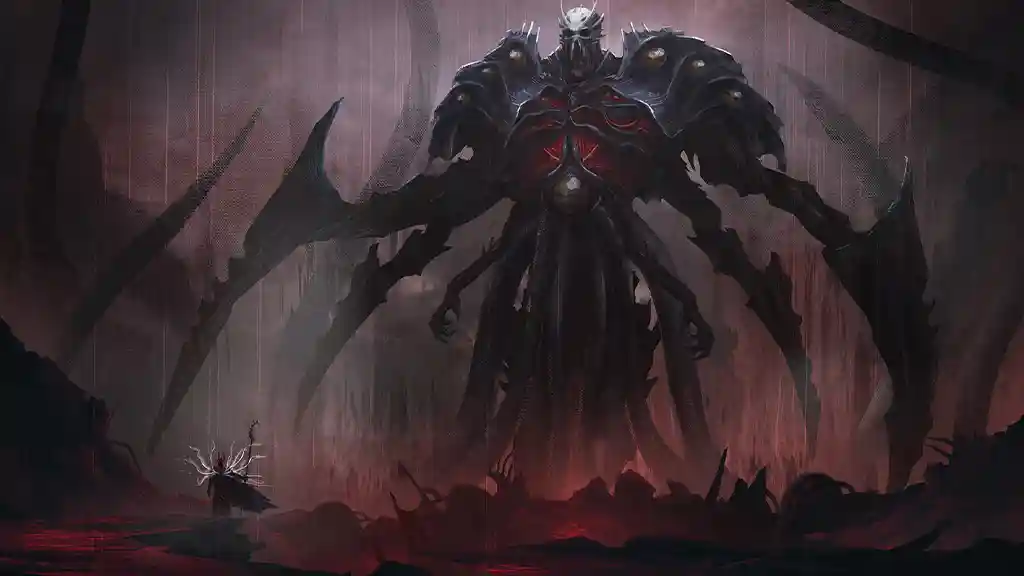
Path of Exile New Player Guide & Overview
October 15, 2023
Introduction
Path of Exile is a free-to-play action role-playing game developed and published by Grinding Gear Games. After an open beta phase, the game officially launched for PC in October 2013. The Game was also released on XBOX One in August 2017, and for Playstation 4 in March 2019.
Players can choose from seven available classes – Duelist, Marauder, Ranger, Scion, Shadow, Templar and Witch. Every class can specialize themself with one of three Ascendancy’s, which will further empower them. Every class has no restriction in what abilities to use, or which talents to pick. The only difference in classes are their Specializations (Ascendancy) and their starting point on the Talent Tree.
The Game can be played in either Regular Mode (Softcore), or Hardcore. There are additional gamemodes called Solo-Self-Found (SSF), or Ruthless. SSF prohibits players from trading and interacting with other players, leaving the player to his/her own destiny. Ruthless is a hardmode version of the game, causing survere loot scarcity and various other changes. Additionally, every 3-4 months there is a new Season added to the game, allowing the community to create new characters in a new Season, exploring a new mechanic, trying to receive new loot. If players dont wish to play a new Season, they can play the ‘Standard League’ in which all their seasonal characters land after the previous Season ends.
Seasonal Leagues
Everytime a new Season is added to the game, players can choose the new Seasonal League to start a fresh character in their chosen gamemode (Softcore, Hardcore, SSF, Ruthless). Players cannot access the loot acquire from the Standard league, forcing all players to start grinding completly new. This also creates a new economy for the seasonal league, causing items to be priced differently in comparison to the Standard League.
Every Season introduces a new exciting mechanic which is added to the game. This new mechanic has a significant impact for the seasonal league, causing various changes in gameplay. At the end of every season, the recently added mechanic will be added to the core-game, causing them to be added to the game additionally with the next upcoming seasonal mechanic.
Example of Seasonal Mechanics:
- Season Mechanic ‘Delirium’ is added to the Game with Patch 3.10.
- This Mechanic causes a mirror to spawn in every map, which spawns additional enemies for a short period of time. The more kills you earn, the higher is the reward at the end of the time. This season also added more features like Cluster Jewels and more.
- Season ‘Delirium 3.10’ ended, Season 3.11 – Harvest is introduced
- Seasonal Mechanic of Harvest is added to the game, Delirium is added as a core-feature. Players can now explore both mechanics in the Seasonal League
As there are currently more then 20 Seasonal Mechanics added as a core-feature to the game, it can be quiet overwhelming for new players to keep track of all of these new mechanics. Most of the mechanics from previous Seasons are not added to the game, and only a light version of them made it into the core game.
We have a full overview of all existing seasonal mechanics which still exist in the Game here.
Players can utilize previous seasonal mechanics for either crafting or earning ingame currency, and even specialize their gameplay around their favorite mechanic as they wish.
Character Selection
Players can choose from seven available classes – Duelist, Marauder, Ranger, Scion, Shadow, Templar and Witch. While every class can utilize every ability in the game, they only differ by the starting point on the talent tree, and their 3 Ascendancies. Ascendancies and Talents can be changed at any time, using Regret Points instead of Talent Points.
Ascendancies are Specializations for your class, empowering a certain niche of the class. Players can switch their Ascendancy, allowing them to play a different ‘Build’ with the same class they chose initially.
- Duelist:
- Slayer – Strong Melee that specializes in Life Leech and Critical Strikes
- Gladiator – Specialize in Melee Damage with additional Block Chance and Bleeding Damage
- Champion – Defensive Melee which takes less damage, intimidates enemies and taunts them
- Marauder:
- Juggernaut – Utilizes strong defensives to mitigate incoming damage
- Berserker – Has increased Critical Strikes but sacrifices Life and takes more damage
- Chieftain – Specialized in using Totems and Fire Damage
- Ranger
- Raider – Strong Evasion Rating while also slightly increasing their Elemental Damage
- Deadeye – Has increased damage with Projectiles
- Pathfinder – Empowers the Flasks equipped by players, and converts damage to either Elemental or Chaos
- Scion:
- Ascendant – Utilize a weaker Ascendancy from all other classes. Multiple Ascendancy choices can be made
- Shadow
- Assassin – Uses either Poisons to deal more damage with Ailments, or reduces damage taken by Elusive
- Trickster – Strong defensives by bolstering their Energy Shield, Evasion Rating and Spell Suppression
- Saboteur – Uses Traps and Mines to deal their most damage
- Templar
- Inquisitor – Uses Consecrated Ground and Critical Strikes with Elemental Damage
- Hierophant – Strong Mana Regeneration and utilizes Totems or Brands
- Guardian – Incredibly strong defensives, which also apply to party members
- Witch
- Occultist – Very strong by using Curses and Chaos Damage
- Elementalist – Elemental Damage as your main damage source, or used as Golemancer
- Necromancer – Specializes in using Minions or utilizing Corpses to deal damage
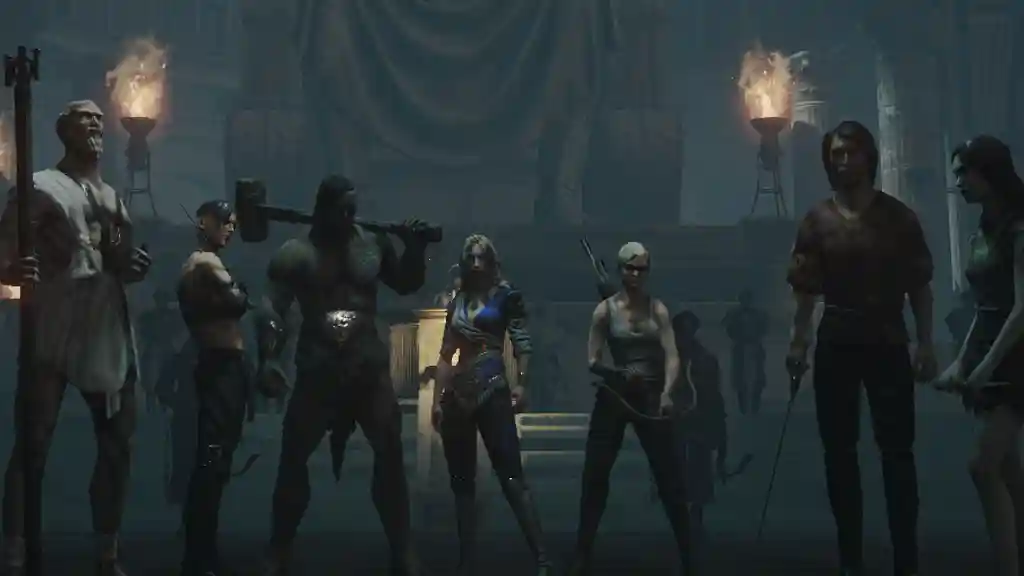
We would highly suggest for players to look into a ‘League Starter Build’. Experienced players have come up with a certain strategy to complete the most difficult content in the game. It can be very overwhelming for new players to decide which class or abilities to use, and maximize their survivability and damage.
Check out our League Starter Builds, designed for New Players here.
Gems and Abilities
In Path of Exile, abilities for your character to use are obtained by equipping a Gem into sockets on your gear. A Gem is either Blue, Green or Red, causing a certain requirement to equip those Gems by either Strength, Intellect or Dexterity. There are two main categories of Gems available in Path of Exile:
- Skill Gem – An active ability which grants an usable skill
- Support Gem – Does not grant a skill itself, but empowers a skill if equipped in a linked socket
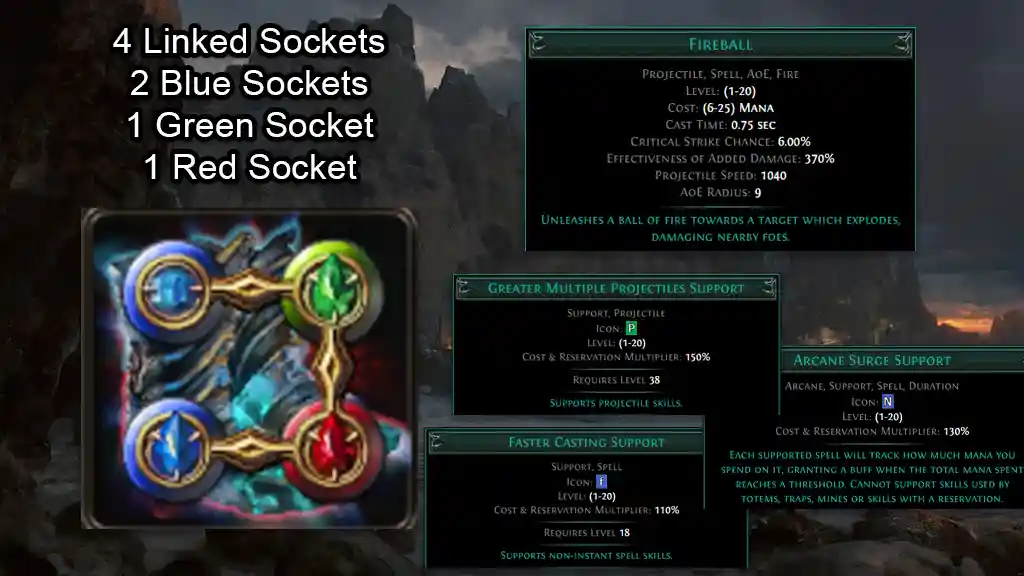
Usually, it is recommended to support an active Skill Gem with as many Support Gems as possible. Your gear offers only a certain amount of possible linked sockets:
- Helmet: 4 Sockets
- Chest: 6 Sockets
- Gloves: 4 Sockets
- Boots: 4 Sockets
- One-handed Weapon: 3 Sockets
- Shield: 3 Sockets
- Bow/Two-handed Weapon: 6 Sockets
Support Gems include the tag “Support” in the top of the Gem description. Otherwise, Gems will always include different tags describing in which way they interact with other gems.
- If a Support Gem supports Projectile Gems, it can only support an Active Skill Gem which includes the Projectile Tag in the top of the Description (i.e Fireball, as shown in the picture above)
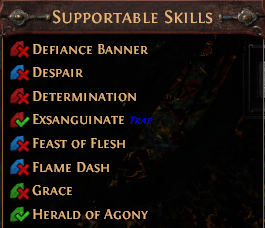 Whenever you mouse-over a specific Support Gem, it will display a window clearly stating if it’s possible to support a specific Gem (Enable Support Gem Utility Popup in Options -> UI -> Items)
Whenever you mouse-over a specific Support Gem, it will display a window clearly stating if it’s possible to support a specific Gem (Enable Support Gem Utility Popup in Options -> UI -> Items)
Talent Tree
The Talent Tree in Path of Exile is always the same for all players and characters. The only difference in the Talent Tree is the specific starting point on the tree for each specific class. You are able to use up to a maximum of 123 Talent Points on your Talent Tree. (127 for Scions)
Depending on the Class that you chose at the start of your journey, reaching a specific Talent on your Tree is going to be more easy if your starting point is close.
- I.e – The Talent “Apply an additional Curse” is located in the Top Right Corner of the Tree
- Every class can reach this point, but a Witch or Shadow are located the closest to it.
Every class starts somewhere located in the middle of the Talent Tree.
- Scion starts in the absolut middle of the Talent Tree
- A Witch starts on the north side of the Talent Tree
- A Shadow starts in the top right side
- A Ranger starts in the bottom right side
- A Duelist starts on the south side of the Talent Tree
- A Marauder starts in the bottom left side
- An Inquisitor starts in the top left side
The starting point on the Talent Tree can be a viable reason to choose a specific class for a certain build, but is not limited to it. This depends on possible other talents located nearby, and especially Ascendancies available for your class (as explained in “Character Selection”)
Gear and Crafting
Gear in Path of Exile do have many complicated modifiers which cause them to be very randomized whenever obtained.
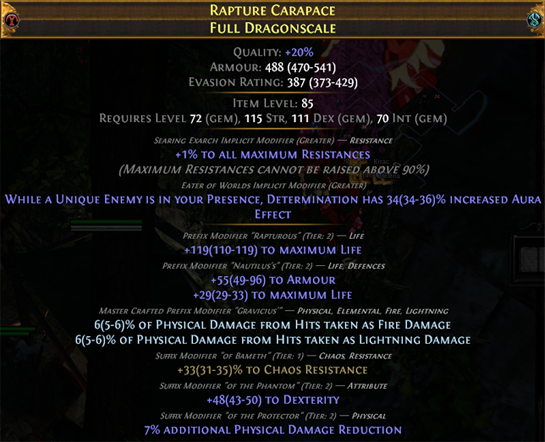
Every item consist of a possible:
- Base Item Value (i.e Armour & Evasion Rating) which is granted by equipping
- Quality of the Item – Can be raised to increase it’s Base Item Value (i.e 20%)
- Implicit are additional modifiers on an item which are granted by various activities (i.e Searing Exarch & Eater of Worlds)
- An item can have up to six affixes, which are divided to either Prefix or Suffix (3 of each)
- Specific stats are always either a Prefix or Suffix (Maximum Life is always a Prefix, Resistances are always Suffix)
- Knowing the differences between a Prefix and Suffix only matters whenever crafting items and trying to add a specific modifier as wished.
Every Affix can have different Tier Levels, increasing it’s value with higher Tiers
- Tier 1 Maximum Life: 120-129 Maximum Life
- Tier 2 Maximum Life: 110-119 Maximum Life
Items also have different Item Levels, allowing higher Tier Ranks of specific Affixes to appear. (Tier 1 Maximum Life requires an Item Level of 84 or higher). Additionally, certain items require a specific amount of either Dexterity, Intellect or Strength to be equippable, like Gems.
Crafting
Players will obtain certain Currency Items during their journey in Path of Exile. These Items are considered a Currency due to their value being used to trade with other players in exchange for their Items.
The most basic Currency which is used by all players, especially during the late Leveling Phase and early Endgame are:
- Jeweller’s Orb – Randomizes the Amount of Sockets on your Item
- Orb of Fusing – Randomizes the Links between all available Sockets on your Item
- Chromatic Orb – Randomizes the Color of all available Sockets on your Item
The most noteworthy way of crafting is the Crafting Table, located in each players Hideout. Recipes can be acquired during the Campaign, or by Unveiling specific Items for the Jun NPC.
This Crafting Table is going to be very important during the Leveling Phase of a player, allowing them to add specific Resistances as a Suffix to their Gear (if the Item does not yet have three Suffixes).
To be able to acquire specific Items during the Endgame which contain your desired Affixes and Implicits, there are various ways in Path of Exile to achieve this. Crafting always involves a certain amount of luck, and can become very time and currency intensive.
We have a full Crafting Guide, explaining all different methods of Endgame Crafting. We suggest new Players to primarily focus on the recipes available on their Crafting Table, and starting to learn crafting slowly by using Essences and other Currency Items. You can find our full Crafting Guide here.
Using the Item shown in the picture above, we want to give an example of how this item was acquired, and which steps of Crafting were involved:
- Randomly loot a “Full Dragonscale” with Item Level 84 or higher.
- The Chaos Resistance Suffix is “Fractured”, meaning it cant be deleted from the Item and will always persist.
- This is a random drop, bought from another player. This can be only acquired with luck, or by using an expensive orb.
- Using “Essence of Greed” on the Item to guarantee Maximum Life Prefix with atleast Tier 2
- Using the Essence multiple times to acquire the Suffix “Additional Physical Damage Reduction”. This Step had to be repeated several times.
The Item now contains “Maximum Life”, the fractured “Chaos Resistance” and the “Physical Damage Reduction”. The Dexterity was randomly added by luck whenever using Essences on the Item. This left this Item with 0 available Suffixes, but 2 available Prefixes.
In our case, the Item had only 1 available Prefix, due to the Essence always reforging the whole Item unpredictable.
- To remove a random Affix, an Orb of Annulment can be used, removing one random Affix. You have to be lucky to remove the undesired Prefix.
- With two available Prefix, we crafted “Physical Damage from Hits taken as Fire/Lightning Damage” on the Crafting Table.
- To add a random Affix (i.e +Armour/Life), we used an Exalted Orb on the item, augmenting a random modifier on either a free Prefix or Suffix.
Leveling
Before players reach the Endgame and finally start exploring the ‘Atlas’, they have to progress through 10 Act’s to unlock the Map Device. This campaign is designed to gradually increase in difficulty, help players to learn certain mechanics of the game. During the leveling phase, players complete quests and earn rewards. Those can be either Gear, additional Talent Points or Regret Points.
We have a fully detailed Leveling Guide for every Act 1-10 prepared here.
During the Campaign, players will defeat Kitava at the end of Act 5 and Act 10. This will cause the player to receive a penalty on their resistances, one their most important defensives, which has to be compensated by better gear or crafting.
Endgame - The Atlas
As soon as players have finished all 10 Act’s of the Campaign, they will unlock the new Map Device. This device allows players to insert Maps and explore the Atlas.
The Atlas & Maps
Immediatly after finishing the Campaign, Kirac will offer players a Map as their reward for killing the final boss of the Campaign. Players will insert the Map into their Map Device and open 6 Portals to their chosen Map.
Whenever players use a portal, is has been depleted and are left with one of six maximum portals left. Whenever a player dies while in a Map, they respawn in their Hideout or in the Town, requiring to use another portal to their Map. As soon as all portals are used, the Map is no longer accessable and all progress and remaining loot in this map is lost.
There are 16 differnt Tier Levels of Maps, indicating different difficulty levels.
Additionally, Maps can have different rarities, similar as Gear. They will also include more modifiers to a Map, the higher the rarity is. Maps can also be corrupted, adding even more modifiers or changing them unpredicatbly. Maps can also increase in quality by using Cartographer’s Chisel‘s.
Players can also use certain Fragments to further increase the difficulty of maps, while also adding additional rewards to it. As soon as players defeat their first Bosses, they will earn specific Voidstones they can permanently socket into their Atlas (Default Button: G), which can additionally provide more rewards/difficulty.
The Atlas Talent Tree
The Atlas Talent Tree (Default Button: Shift-G) offers players a new Talent Tree which they can specialize their playstyle towards specific League Mechanics. Atlas Talent Points can be achieved by completing all Maps in the game with increased difficulty
- Tier 1-5 Maps: Requires atleast Magic Rarity
- Tier 6-10 Maps: Requires atleast Rare Rarity
- Tier 11-16 Maps: Requires atleast Rare + Corrupted Rarity
- Unique Maps: Requires just regular completion
Those Atlas Talent Points do not necessarily increase any character power, but instead empower specific League Mechanics in the game, offering higher rewards. With these Atlas Talent Points, you can also empower certain Unique Boss Maps in order to activate their Uber-Variant, which are considered the hardest bosses in the game.
To find a full list of League Mechanics and their potential rewards, check out our League Mechanic Summary here.
Bosses and Uber-Bosses
There are many Boss Maps to be found in Path of Exile. Those Bosses are considered the hardest enemies in the game, yielding very unique and expensive items that can only be rarely obtained after defeating them.
To be able to defeat those Bosses, players have to reach a very high level and have a smartly configured Build which outputs a lot of damage and survivability.
These bosses can only be accessed by inserting multiple specific fragments or a unique map into your Map Device. Depending on which Boss, this requires a lot of previous farming, or specific smaller Boss kills.